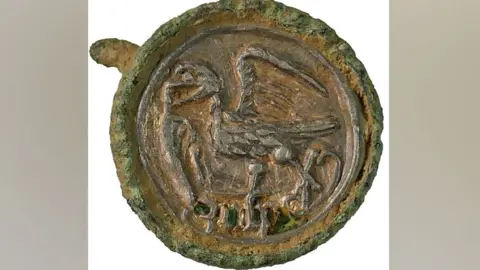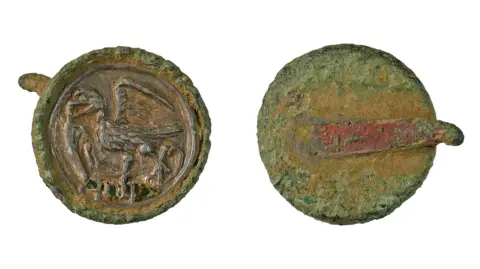Tudor hat badge offers 'rare chance to trace owner'
 Suffolk County Council
Suffolk County CouncilThe discovery of a man's Tudor-era hat badge offers "a rare opportunity to identify a possible owner", said an expert.
The copper alloy and silver post-medieval pin or hook features a bird of prey with a raised wing and the letters 'IOH' just underneath its feet.
It was found in a field close to Little Sampford, near Finchingfield, Essex, and dates to a time when "clothing was all about displaying your wealth and status".
Essex finds liaison officer Lori Richardson said more research might reveal who lost the badge at some point in the 16th Century.
 Getty Images
Getty Images"Names were not common features on hat badges and so this one offers us a rare opportunity to identify a possible owner," said Miss Rogerson.
Elite men were just as likely as women in this era to decorate their hats with feathers, brooches or badges.
It was also a time when sumpturary laws attempted to restrict what could be worn by people from different levels of class.
Miss Rogerson said the object "tells us that he identified with the heraldic device depicted, a bird of prey, either through his family coat of arms or through his allegiance to a particular royal - he was clearly a nobleman".
 Suffolk County Council
Suffolk County CouncilTreasure finds can be reported to any county finds liaison officer and this discovery was reported to Anna Booth from Suffolk.
Her report to the coroner suggested its owner's name was "probably John, although it is difficult to decipher in its current condition".
It could have belonged to a member of the Greene family, who lived at Little Samford Hall during the 16th Century, "although the bird of prey does not appear in their coat of arms", she said.
Alternatively, it could have belonged to the Essex branch of the Tweedy family, whose arms featured a bird rolant argent as their crest, Dr Booth added.
A museum is hoping to acquire the piece.
Follow Essex news on Facebook, Instagram and X. Got a story? Email [email protected] or WhatsApp us on 0800 169 1830
